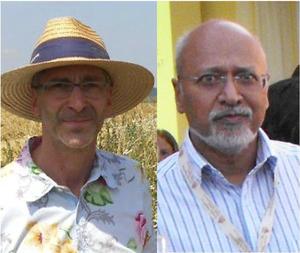
Inspired by the discussions held during ENDURE's 2012 Summer School focusing on the use of agroecology for crop protection on European farms, Alain Ratnadass (pictured right) and Marco Barzman (left), two of the course's experts, have produced a chapter examining a number of historical pathways aiming at fitting crop protection within sustainable agriculture.
Writing in 'Sustainable Agriculture Reviews', Alain, from France's institute of agricultural research for development (CIRAD), and Marco, from France's National Institute for Agricultural Research (INRA), look at the nature and history of biodynamic agriculture, organic farming, Integrated Pest Management, agroecology and ecological intensification. Their review highlights the role of crop protection products - be they synthetic or natural - and reliance on ecosystem processes in each school of thought.
Their analysis cuts across the traditional opposition between conventional and organic farming sectors. They point out that high-input approaches can be found in either sector. There are for example 'Intelligent Pesticide Management' versions of IPM, or industrial forms of organic farming highly reliant on products, as well as no-till soil conserving systems dependent upon the use of both synthetic herbicides and genetically modified herbicide-tolerant crops.
To make crop protection more compatible with sustainable agriculture, they adopt the views of previous authors who have identified two major approaches depending on two contrasting farming circumstances:
- Reducing pesticide use and increasing reliance on natural processes and agronomic practices in the context of intensive high-input agricultural.
- Increasing productivity while maintaining ecological functions at high levels in more traditional low-tech systems.
For either approach, they identify a holy grail of crop protection they refer to as 'ultimate IPM', an ideal situation where no in-season crop protection intervention is needed. The road towards ultimate IPM, they argue, will benefit from insights from both IPM - often emerging from the conventional intensive realm - as well as from agroecology or ecological intensification, inspired by more low input traditional systems. In this mindset, IPM is more about reducing reliance on pesticides and ecological intensification about promoting ecosystemic services. The authors therefore conclude that the two are complementary, one taking elements away from a conventional system to favour natural processes, the other adding elements to a more 'natural' system to make it more productive.
The authors also offer a selection of case studies from tropical agriculture to illustrate how crop protection solutions in ecologically intensive systems may or may not be compatible with the principles of IPM. For example, seed for upland rice production in conservation agriculture systems in Madagascar is systematically dressed with an insecticide to protect the crop against black beetles. Such a systematic use of insecticide is clearly not in line with IPM principles. However, this technique can be part of the ecological intensification approach as it makes it possible to adopt Direct-seeding, Mulch-based Cropping (DMC) systems which provide significant ecosystem services, such as soil conservation and carbon sequestration.
The authors provide an example of a crop protection solution perfectly suited to ecologically intensive systems which could also serve as an example of ultimate IPM. This is based on the use of weaver ants to protect tropical tree crops, a practice used for hundreds of years in Vietnam, and harnessing ecological processes in orchards or groves, particularly using plant diversity, to improve the positive actions of these ants.
Taken from: Alain Ratnadass and Marco Barzman, Ecological Intensification for Crop Protection, in H. Ozier-Lafontaine and M. Lesueur-Jannoyer (eds.), Sustainable Agriculture 53 Reviews 14: Agroecology and Global Change, Sustainable Agriculture Reviews 14, DOI: 10.1007/978-3-319-06016-3_3, © Springer International Publishing Switzerland 2014.
For more information: